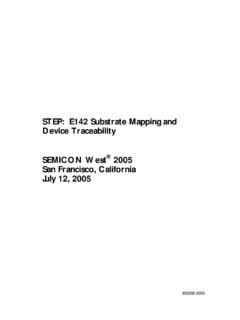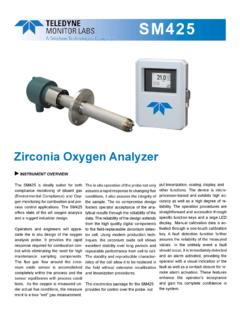Transcription of Towards a Model for Impact of Technology …
1 Towards a Model for Impact of Technology Evolution on Wafer-Level ESD Damage SusceptibilityLou DeChiaro Terry Welsher 2007 Dangelmayer Associates2 Setting the Stage Wafer level ESD damage has long been a mystery Investigators lacked tools to detect events in situ Often yields were low and any ESD was masked by other handling-induced errors Early robotic equipment was more sensitive than the wafers Electrostatic attraction (ESA) emerged as the more significant problem Some ESA mitigation techniques probably also reduce ESD risk ESD vulnerability very dependent on specific wafer construction Attitudes range widely from indifference to serious concern Little being done, few actual investigationsCopyright 2007 Dangelmayer Associates3 Some Prior Work Early processing at AT&T (1970-1980) Failures at wafer level a major problem Burr Brown (1991 EOS/ESD Symposium) - streaming potential causes ESD damage at wafer rinse Seagate (1998 EOS/ESD symposium) Damage to MR Heads at Ion Milling (not really ESD but vulnerabilities may be similar) Jacob & Nicoletti (2006 IEEE Trans Dev Mat Rel) Allude to ESD damage directly to chip surface Copyright 2007 Dangelmayer Associates4 Some Prior Work Infineon (2006 EOS/ESD Symposium)
2 - claim no damageat wafer saw Infineon 2007 Future-Fab article On-going efforts to eliminate ESD events driven by fear of device damage but no direct evidence cited Damage at wafer saw Direct experienceCopyright 2007 Dangelmayer Associates5 Wafer Saw ESD EventsWafer Saw 6351 CO2 bubbler onWafer Saw 6351 CO2 bubbler offEvents captured by ESD event detectorCopyright 2007 Dangelmayer Associates6 ESD Threshold Populations including high speed applicationsESD Populations including high speed Threshold (volts)Relative Frequency199620022008HS 1996HS 2002HS 2008 Distribution becoming bimodalCopyright 2007 Dangelmayer Associates705001000150020002500198019851 9901995200020052010 HBMCDMMMESDA Technology RoadmapVoltsHBMCDMMMC opyright 2007 Dangelmayer Associates8 Wafer Level ESD Model Details of the Model Results Limitations and ImprovementsCopyright 2007 Dangelmayer Associates9 Objectives Create a framework for predicting voltage levels on wafers due to ESD in the front-end environment Estimate how geometric changes in wafer construction affect ESD vulnerability Identify processing and feature scale information needed to improve estimatesStrategy Develop a computer Model for typical wafer-level ESD event Base Model on a charged-device Model (CDM) scenario (wafer grounded in a static field)
3 Wafer-Level ESD ModelCopyright 2007 Dangelmayer Associates10 Charged Device ModelCopyright 2007 Dangelmayer Associates11 FCDM SimulatorCopyright 2007 Dangelmayer Associates12 Model Description Integrated Wafer-Simulator CDM Model Wafer modeled as an array of capacitances with respect to the field source Technology evolution related to this capacitance variation Feature-to-feature and feature-to backside capacitances are small and neglected for this analysis Feature-to-feature potential differences used as an indicator of device failure Thermal effects were not considered since any significant heating would be on back side of wafer well away from sensitive features Changes to new materials ( , ZrO2) are not included The following lumped-elements were used in circuit Model for the CDM generator Nonlinear arc resistance Ground probe inductanceCopyright 2007 Dangelmayer Associates13 Wafer ESD Model SchematicField plate at V Arc Model , I(t)- Includes inductanceSmall featuresLarge busBulk resistanceV(t)surface resistancesmall caplarge capneglectedneglectedCopyright 2007 Dangelmayer Associates14 Modeling sequence Field plate (simulating charged source near wafer) is charged to the desired stressing voltage This causes the entire wafer to rise or fall to the desired stressing potential A simulated grounded probe is then placed into electrical contact (through an arc) with the backside of the wafer to simulate a typical wafer handling electrostatic event The metal islands (capacitors)
4 On the front side then discharge through the underlying silicon substrate The quasi-steady-state static potential and the electric field are then computed as functions of position and time while the simulation proceeds Voltage potentials develop between the metal islands with the highest potentials typically between neighboring islands with different capacitancesCopyright 2007 Dangelmayer Associates15 Failure Mechanism A fast transient leads to voltage potential between features Sufficiently high voltage for sufficient duration initiates Fowler-Nordheim (F-N) tunneling* Failure occurs when cumulative charge trapping exceeds a certain level defined as Qbd*See S. Sze, Physics of Semiconductor Devices, Second Edition, 2007 Dangelmayer Associates16 Failure Model For 5 kV ESD event, peak V is 50-250 volts across top side chip features. This V may appear across thin gate oxide.
5 F-N tunneling current density (J) given by Total charge density deposited into gate oxide during FCDM event given as ox= J(t)dt. For FCDM event, duration is brief, but J is large. If ox> Qbd, gate oxide fails irreversibly. This could cause failure of MOSFETs internal to DUT, not necessarily in I/O regions more difficult to detect. Detection of such failures depends upon vector set fault coverage. Failure would appear as a hard functional failure, notnecessarily as a parametric leakage failure)/exp(221 EcEcJ =Copyright 2007 Dangelmayer Associates17 Ignoring Inter-feature Capacitance For this Model , inter-feature capacitances are paralleled by inter-feature resistance of 1/(g*mesh spacing). This resistance is about ohm. Consider a ohm resistor in parallel with an inter-feature capacitor of pF. Compare resistor conduction current ( V/R) & capacitor displacement current (Cdv/dt).
6 For 5 kV event, peak Icond= 25 A.; peak Idis= A. Conduction current dominates capacitor displacement current. So, we ve ignored inter-feature capacitance. Addition of inter-feature capacitance to Model is always possible at client 2007 Dangelmayer Associates18 Simulation Runs Variables explored Large and small capacitance values Bulk wafer conductivity Back surface conductivity Stressing voltage Zap location Fixed quantities Wafer thickness Feature spacing Arc Model with fixed voltage/lengthCopyright 2007 Dangelmayer Associates19 Typical waveformCurrent waveform5000 (nse c)arc current (Amps)Copyright 2007 Dangelmayer Associates20 Typical wafer potential difference distributionsDifference in potential from zap point5000 volt (mm)voltagePotential differences between neighboring position (mm)point-to-point voltage (v)Software also produces animated plotsofkey variablesCopyright 2007 Dangelmayer Associates21 Results summary plotsmaximum potential difference vs small feature (small cap) (pF)
7 Voltscond= potential difference vs small feature (small cap) (pF)max voltage diff (v)5000v10000vMaximum potential difference vs. small feature capacitance for 5kV and 10kV zapsBulk conductivity = potential difference vs. small feature capacitance for various conductivities and zap voltage 5kVCopyright 2007 Dangelmayer Associates22 Summary and Conclusions Changes in relative capacitance with respect to charge source of neighboring features could have significant effect on voltage differentials between features on a die Maximum voltage potentials appear for ~100 picoseconds at or near the time of current peak and at point of larger capacitance Maximum feature-to-feature potentials roughly scale with zap voltageCopyright 2007 Dangelmayer Associates23 Summary and Conclusions(cont.) Need to relate small-to-large capacitance range to Technology evolution Failures would be difficult to detect based on current test techniques since they would be internal, depend on test coverage Status: These results suggest that relatively high voltages can be developed on wafer-like structures.
8 Further work is required to firmly establish the calibration of the results using actual Qbd, capacitances and conductivities







